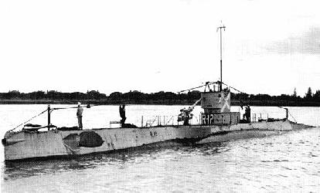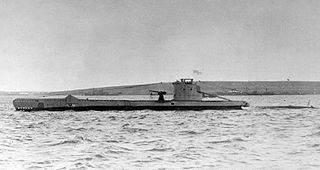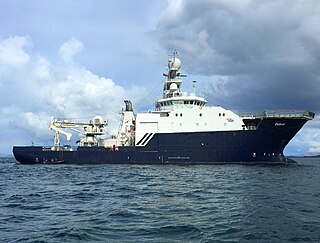Related Research Articles

Robert Duane Ballard is an American retired Navy officer and a professor of oceanography at the University of Rhode Island who is noted for his work in underwater archaeology and marine geology. He is best known by the general public for the discoveries of the wrecks of the RMS Titanic in 1985, the battleship Bismarck in 1989, and the aircraft carrier USS Yorktown in 1998. He discovered the wreck of John F. Kennedy's PT-109 in 2002 and visited Biuku Gasa and Eroni Kumana, who saved its crew.
I-52, code-named Momi was a Type C3 cargo submarine of the Imperial Japanese Navy used during World War II for a secret mission to Lorient, France, then occupied by Germany, during which she was sunk.

USS R-12 (SS-89) was an R-class coastal and harbor defense submarine of the United States Navy.

HMAS AE1 was an E-class submarine of the Royal Australian Navy (RAN). She was the first submarine to serve in the RAN, and sank with all hands near what is now East New Britain, Papua New Guinea, on 14 September 1914, after less than seven months in service. Search missions attempting to locate the wreck began in 1976. The submarine was found during the 13th search mission near the Duke of York Islands in December 2017.

USS Grunion (SS-216) was a Gato-class submarine that sank at Kiska, Alaska, during World War II. She was the only ship of the United States Navy to be named for the grunion.

USS Grayback (SS-208), a Tambor-class submarine, was the first ship of the United States Navy to be named for the lake herring, Coregonus artedi. She ranked 20th among all U.S. submarines in total tonnage sunk during World War II, with 63,835 tons, and 24th in number of ships sunk, with 14. She was sunk near Okinawa on 27 February 1944. Her wreck was discovered in June 2019.

USS Harder (SS-257), a Gato-class submarine, was the first ship of the United States Navy to be named for the harder, a fish of the mullet family found off South Africa. One of the most famous submarines of World War II, she received the Presidential Unit Citation. Her commanding officer throughout her service, the resolute and resourceful Commander Samuel D. Dealey (1906–1944), "a submariner's submariner", was posthumously awarded the Medal of Honor, as well as four Navy Crosses during his lifetime.

A midget submarine is any submarine under 150 tons, typically operated by a crew of one or two but sometimes up to six or nine, with little or no on-board living accommodation. They normally work with mother ships, from which they are launched and recovered and which provide living accommodation for the crew and support staff.

USS Abner Read (DD-526) was a Fletcher-class destroyer in the service of the United States Navy, named after Lieutenant Commander Abner Read, who fought in the American Civil War. The ship fought in World War II, seeing action in the Aleutian Islands Campaign and in 1943 she survived hitting a mine that blew off her stern. After repairs, she returned to service and operated in support of Allied forces in the New Guinea campaign and the Battle of Leyte. She was sunk in an air attack off Leyte on 1 November 1944.

German submarine U-166 was a Type IXC U-boat of Nazi Germany's Kriegsmarine during World War II. The submarine was laid down on 6 December 1940 at the Seebeckwerft at Wesermünde as yard number 705, launched on 1 November 1941, and commissioned on 23 March 1942 under the command of Oberleutnant zur See Hans-Günther Kuhlmann. After training with the 4th U-boat Flotilla, U-166 was transferred to the 10th U-boat Flotilla for front-line service on 1 June 1942. The U-boat sailed on only two war patrols and sank four ships totalling 7,593 gross register tons (GRT). She was sunk on 30 July 1942 in the Gulf of Mexico.

American Heroes Channel is an American multinational pay television channel owned by the Warner Bros. Discovery Networks unit of Warner Bros. Discovery. The network carries programs related to the military, warfare, and military history and science.

The Type XVII U-boats were small coastal submarines that used a high-test peroxide propulsion system, which offered a combination of air-independent propulsion and high submerged speeds.
Liberty Station is a mixed-use development in San Diego, California, on the site of the former Naval Training Center San Diego. It is located in the Point Loma community of San Diego. It has a waterfront location, on a boat channel off San Diego Bay, just west of San Diego International Airport and a few miles north of downtown San Diego. The 361-acre (1.46 km2) project includes several distinct districts: a retail and commercial district, a promenade focused on nonprofit activities, an arts district, educational district, residential district, hotel district, office district, and a park/open space area along the boat channel.

HMS Urge was a British U-class submarine, of the second group of that class, built by Vickers Armstrong, Barrow-in-Furness. She was laid down on 30 October 1939, and was commissioned on 12 December 1940. From 1941 to 1942 she formed part of the 10th Submarine Flotilla based in Malta and spent most of her career operating in the Mediterranean, where she damaged and sank enemy warships and merchant vessels and undertook both SBS and SIS special operations. She was commanded by Lieutenant-Commander Edward Philip Tomkinson, DSO, RN. She was lost with all hands and a number of naval passengers on 27 April 1942 after striking a German mine off Malta.

HMSOlympus was an Odin-class submarine, a class originally designed for the Royal Australian Navy to cope with long distance patrolling in Pacific waters. Olympus was built to the same design for the Royal Navy. She served from 1931 to 1939 on the China Station and 1939-1940 out of Colombo. In 1940 she went to the Mediterranean. She was sunk by a mine off Malta in May 1942 killing 89 crew. 9 survivors: Herbert Rawlings,

K-129 was a Project 629A diesel-electric-powered ballistic-missile submarine that served in the Pacific Fleet of the Soviet Navy. It was one of six Project 629 strategic ballistic-missile submarines assigned to the 15th Submarine Squadron based at Rybachiy Naval Base near Petropavlovsk-Kamchatsky, commanded by Rear Admiral Rudolf Golosov.
David Walter Jourdan is an author, founder of Meridian Sciences, and the co-founder and president of Nauticos, a deep ocean exploration company. He studied physics and engineering at the U.S. Naval Academy and Johns Hopkins University, and served as a U.S. Navy submarine officer during the Cold War. Jourdan and his Nauticos team have made a number of notable deep ocean discoveries, including the missing Israeli submarine INS Dakar in the Mediterranean and the Japanese aircraft carrier Kaga, sunk in the Battle of Midway. He has led two deep ocean expeditions in search of Amelia Earhart and Fred Noonan’s Lockheed Electra airplane in the ocean off Howland Island, the atoll Earhart and Noonan were attempting to find when they vanished. He has published several books, Never Forgotten: the Search and Discovery of Israel's Lost Submarine Dakar; The Deep Sea Quest for Amelia Earhart.; and The Search for the Japanese Fleet: USS Nautilus and the Battle of Midway.

RV Petrel, or R/V Petrel, is a 76.45 m (250.8 ft) research vessel sailing under the UK flag and owned by the United States Navy and once owned by Microsoft co-founder Paul Allen. The ship is named after the petrel, a sea bird. The ship was completed by Brattvaag Skipsverft, Norway in 2003 as the deepwater offshore inspection vessel Seaway Petrel for service with Stolt Offshore. She was later renamed Acergy Petrel, then Seven Petrel with Subsea 7.
This page lists major events of 2019 in archaeology.
References
- ↑ Lost 52 Project
- ↑ United States Submarine Losses
- ↑ US Navy validates final resting place of WWII submarine S-28.
- ↑ "7th WWII Submarine Discovered by Explorer Tim Taylor's 'Lost 52 Project'". PR Newswire . Cision. August 4, 2020. Retrieved May 25, 2023.
- ↑ "Veteran ocean explorer discovers WWII submarine in South China Sea". NBC News. May 22, 2024. Retrieved May 22, 2024.